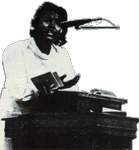|
 Nonviolence:
SNCC's original statement of purpose established nonviolence as
the driving philosophy behind the organization. However, things
were never that simple. In the early days, during the period of
the sit-in movement, nonviolent action was strictly enforced,
particularly for public demonstrations, as it was key to the movement's
success. (more) Nonviolence:
SNCC's original statement of purpose established nonviolence as
the driving philosophy behind the organization. However, things
were never that simple. In the early days, during the period of
the sit-in movement, nonviolent action was strictly enforced,
particularly for public demonstrations, as it was key to the movement's
success. (more)
 Vietnam:
SNCC formally came out against the Vietnam War in the beginning
of 1966 as a result of pressure from northern supporters and from
members working on the southern projects. In one instance, the
McComb, Mississippi project went as far as releasing its own antiwar
pamphlet. Such events may have pushed SNCC towards releasing an
official opinion, but the murder of Sammy Younge was the catalyst.
Younge was a SNCC worker and a Tuskegee Institute Student who
lost his kidney in Vietnam. (more) Vietnam:
SNCC formally came out against the Vietnam War in the beginning
of 1966 as a result of pressure from northern supporters and from
members working on the southern projects. In one instance, the
McComb, Mississippi project went as far as releasing its own antiwar
pamphlet. Such events may have pushed SNCC towards releasing an
official opinion, but the murder of Sammy Younge was the catalyst.
Younge was a SNCC worker and a Tuskegee Institute Student who
lost his kidney in Vietnam. (more)
 White
Liberalism: Early in SNCC's history a rift began to form between
the organization and its white liberal support. When SNCC initially
began its pro.mp3 of sit-ins and other forms of nonviolent protest,
they hoped it would create such a compelling image of violent
oppression that northern white liberals would become incensed
by the situation (more) White
Liberalism: Early in SNCC's history a rift began to form between
the organization and its white liberal support. When SNCC initially
began its pro.mp3 of sit-ins and other forms of nonviolent protest,
they hoped it would create such a compelling image of violent
oppression that northern white liberals would become incensed
by the situation (more)
 Feminism:
Many people feel that SNCC opened the door for the feminist movement,
as it first established many of the principles later use by feminists.
SNCC sought to change society by creating alternative institutions,
instead of altering the existing ones. It rallied the oppressed
by glorifying their qualities, and it viewed prejudice, in the
form of racism or sexism, as a core social problem. (more) Feminism:
Many people feel that SNCC opened the door for the feminist movement,
as it first established many of the principles later use by feminists.
SNCC sought to change society by creating alternative institutions,
instead of altering the existing ones. It rallied the oppressed
by glorifying their qualities, and it viewed prejudice, in the
form of racism or sexism, as a core social problem. (more)
 Black
Power: Black Power was the guiding philosophy of SNCC in its
later years. It began to develop and take hold sometime after
1964, and came to prominence in 1966 when Stokely Charmicael became
head of the organization. (more) Black
Power: Black Power was the guiding philosophy of SNCC in its
later years. It began to develop and take hold sometime after
1964, and came to prominence in 1966 when Stokely Charmicael became
head of the organization. (more)
|





